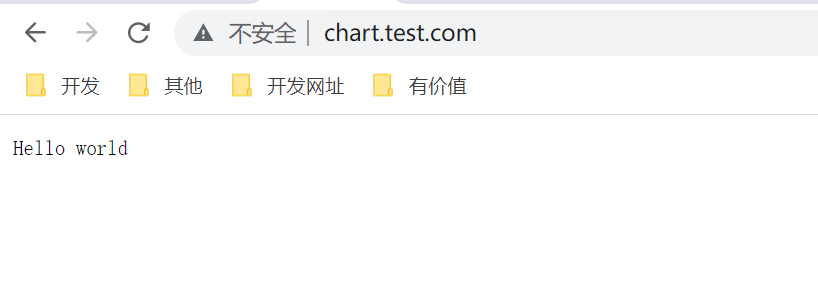k8s(18)-- 创建一个Helm Chart
创建一个Helm Chart
1. 应用准备
准备一个简单的golang http服务:
main.go
package main
import (
"fmt"
"log"
"net/http"
"os"
)
func main() {
port := os.Getenv("PORT")
if port == "" {
port = "8080"
}
username := os.Getenv("USERNAME")
if username == "" {
username = "world"
}
http.HandleFunc("/", func(w http.ResponseWriter, r *http.Request) {
fmt.Fprintf(w, "Hello %s\n", username)
})
log.Println("go hello world starting...")
err := http.ListenAndServe(":"+port, nil)
if err != nil {
panic(err)
}
}
Dockerfile:
FROM golang:1.17.1 as builder
WORKDIR /app
COPY main.go .
ENV CGO_ENABLED=0
RUN go build -o hello-world main.go
FROM alpine:latest
WORKDIR /app
COPY --from=builder /app/hello-world /app/hello-world
ENTRYPOINT ["/app/hello-world"]
EXPOSE 8080
[root@master test]# docker build -t ms/go-hello-world:1.0 .
上传到docker仓库中:
[root@master test]# docker tag ms/go-hello-world:1.0 mszlu/go-hello-world:1.0
[root@master test]# docker push mszlu/go-hello-world:1.0
The push refers to repository [docker.io/mszlu/go-hello-world]
05feaa071f42: Pushed
6b42f5d48464: Pushed
9fb3aa2f8b80: Mounted from library/alpine
1.0: digest: sha256:26a7e9362e1a8fab51d38b0cc5ec1d36723850ab57aa15802d489843ae2cb2ec size: 946
2. 创建Chart
[root@master test]# helm create hello-world
Creating hello-world
2.1 Chart.yaml
apiVersion: v2
name: hello-world
description: ms go hello world chart
type: application
version: 0.1.0
appVersion: "1.16.0"
2.2 values.yaml
replicas: 2
image:
repository: mszlu/go-hello-world
pullPolicy: IfNotPresent
tag: "1.0"
service:
type: ClusterIP
port: 80
targetport: 8080
ingress:
enabled: true
annotations: {}
hosts:
- host: chart.test.com
paths: /
tls: []
resources:
limits:
cpu: 200m
memory: 256Mi
requests:
cpu: 100m
memory: 128Mi
autoscaling:
enabled: false
minReplicas: 1
maxReplicas: 100
targetCPUUtilizationPercentage: 80
targetMemoryUtilizationPercentage: 80
nodeSelector: {}
2.3 模板简单修改:
_helpers.tpl
{{/*
资源名称
*/}}
{{- define "hello-world.fullname" -}}
{{- default .Chart.Name .Values.nameOverride | trunc 63 | trimSuffix "-" }}
{{- end }}
{{/*
公共标签选择器
*/}}
{{- define "hello-world.labels" -}}
app: {{ template "hello-world.fullname" . }}
release: {{ .Release.Name }}
chart: {{ .Chart.Name }}
{{- end }}
{{/*
标签选择器
*/}}
{{- define "hello-world.selectorLabels" -}}
app: {{ template "hello-world.fullname" . }}
release: {{ .Release.Name }}
{{- end }}
2.4 deployment.yaml
apiVersion: apps/v1
kind: Deployment
metadata:
name: {{ include "hello-world.fullname" . }}
labels:
{{- include "hello-world.labels" . | nindent 4 }}
spec:
{{- if not .Values.autoscaling.enabled }}
replicas: {{ .Values.replicaCount }}
{{- end }}
selector:
matchLabels:
{{- include "hello-world.selectorLabels" . | nindent 6 }}
template:
metadata:
labels:
{{- include "hello-world.selectorLabels" . | nindent 8 }}
spec:
containers:
- name: {{ .Chart.Name }}
image: "{{ .Values.image.repository }}:{{ .Values.image.tag | default .Chart.AppVersion }}"
imagePullPolicy: {{ .Values.image.pullPolicy }}
{{- if .Values.resources }}
resources:
{{- toYaml .Values.resources | nindent 12 }}
{{- else }}
resources: {}
{{- end }}
2.5 ingress.yaml
{{- if .Values.ingress.enabled -}}
{{- $fullName := include "hello-world.fullname" . -}}
{{- $svcPort := .Values.service.port -}}
{{- $paths := .Values.ingress.paths -}}
apiVersion: networking.k8s.io/v1
kind: Ingress
metadata:
name: {{ $fullName }}
labels:
{{- include "hello-world.labels" . | nindent 4 }}
{{- with .Values.ingress.annotations }}
annotations:
{{- toYaml . | nindent 4 }}
{{- end }}
spec:
ingressClassName: nginx
{{- if .Values.ingress.tls }}
tls:
{{- range .Values.ingress.tls }}
- hosts:
{{- range .hosts }}
- {{ . | quote }}
{{- end }}
secretName: {{ .secretName }}
{{- end }}
{{- end }}
rules:
{{- range .Values.ingress.hosts }}
- host: {{ .host | quote }}
http:
paths:
- path: {{ .paths }}
pathType: Prefix
backend:
service:
name: {{ $fullName }}
port:
number: {{ $svcPort }}
{{- end }}
{{- end }}
2.6 service.yaml
apiVersion: v1
kind: Service
metadata:
name: {{ include "hello-world.fullname" . }}
labels:
{{- include "hello-world.labels" . | nindent 4 }}
spec:
type: {{ .Values.service.type }}
ports:
- port: {{ .Values.service.port }}
targetPort: {{ .Values.service.targetport }}
protocol: TCP
name: http
selector:
{{- include "hello-world.selectorLabels" . | nindent 4 }}
2.7 NOTES.txt
1. Get the application URL by running these commands:
{{- if .Values.ingress.enabled }}
http{{ if $.Values.ingress.tls }}s{{ end }}://{{- range .Values.ingress.hosts }}{{ .host }}{{.paths}}{{end}}
{{- else if contains "NodePort" .Values.service.type }}
export NODE_PORT=$(kubectl get --namespace {{ .Release.Namespace }} -o jsonpath="{.spec.ports[0].nodePort}" services {{ include "hello-world.fullname" . }})
export NODE_IP=$(kubectl get nodes --namespace {{ .Release.Namespace }} -o jsonpath="{.items[0].status.addresses[0].address}")
echo http://$NODE_IP:$NODE_PORT
{{- else if contains "LoadBalancer" .Values.service.type }}
NOTE: It may take a few minutes for the LoadBalancer IP to be available.
You can watch the status of by running 'kubectl get --namespace {{ .Release.Namespace }} svc -w {{ include "hello-world.fullname" . }}'
export SERVICE_IP=$(kubectl get svc --namespace {{ .Release.Namespace }} {{ include "demo.fullname" . }} --template "{{"{{ range (index .status.loadBalancer.ingress 0) }}{{.}}{{ end }}"}}")
echo http://$SERVICE_IP:{{ .Values.service.port }}
{{- else if contains "ClusterIP" .Values.service.type }}
export POD_NAME=$(kubectl get pods --namespace {{ .Release.Namespace }} -l "app.kubernetes.io/name={{ include "hello-world.fullname" . }},app.kubernetes.io/instance={{ .Release.Name }}" -o jsonpath="{.items[0].metadata.name}")
echo "Visit http://127.0.0.1:8080 to use your application"
kubectl --namespace {{ .Release.Namespace }} port-forward $POD_NAME 8080:80
{{- end }}
3. 试运行
[root@master test]# helm install web hello-world/ --dry-run
NAME: web
LAST DEPLOYED: Tue Sep 20 15:25:28 2022
NAMESPACE: default
STATUS: pending-install
REVISION: 1
TEST SUITE: None
HOOKS:
MANIFEST:
---
# Source: hello-world/templates/service.yaml
apiVersion: v1
kind: Service
metadata:
name: hello-world
labels:
app: hello-world
release: web
chart: hello-world
spec:
type: ClusterIP
ports:
- port: 80
targetPort: 8080
protocol: TCP
name: http
selector:
app: hello-world
release: web
---
# Source: hello-world/templates/deployment.yaml
4. 安装
[root@master test]# helm install web hello-world/ -n dev
NAME: web
LAST DEPLOYED: Tue Sep 20 15:27:35 2022
NAMESPACE: dev
STATUS: deployed
REVISION: 1
TEST SUITE: None
NOTES:
1. Get the application URL by running these commands:
http://chart.test.com/
[root@master test]# helm list -n dev
NAME NAMESPACE REVISION UPDATED STATUS CHART APP VERSION
web dev 1 2022-09-20 15:27:35.425054994 +0800 CST deployed hello-world-0.1.0 1.16.0
[root@master test]# kubectl get pods -n dev
NAME READY STATUS RESTARTS AGE
hello-world-5f58b77b87-cm2fp 1/1 Running 0 43s
[root@master test]# kubectl get ingress -n dev
NAME CLASS HOSTS ADDRESS PORTS AGE
hello-world nginx chart.test.com 80 96s
[root@master test]# kubectl get svc -n dev
NAME TYPE CLUSTER-IP EXTERNAL-IP PORT(S) AGE
hello-world ClusterIP 10.96.220.214 <none> 80/TCP 114s
访问浏览器:http://chart.test.com/ 验证是否正常

一定要记得安装ingress环境,在入门教程中,我们已经安装过
注意遇到网络问题:
#删除对应节点的cnio
[root@node2 ~]# ifconfig cni0 down
[root@node2 ~]# ip link delete cni0
#删除coredns的pod 让其重建 原因是网络未配置正确 coredns 应该运行在工作节点才对
[root@master test]# kubectl delete pod coredns-6d8c4cb4d-wphbn -n kube-system
pod "coredns-6d8c4cb4d-wphbn" deletedk8s(18)-- 创建一个Helm Chart
http://47.123.5.226:8090//archives/k8s-18----chuang-jian-yi-ge-helm-chart